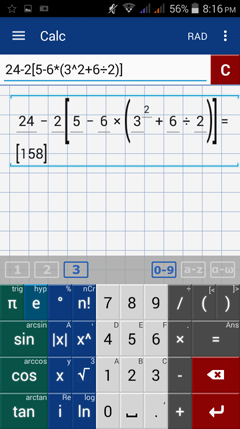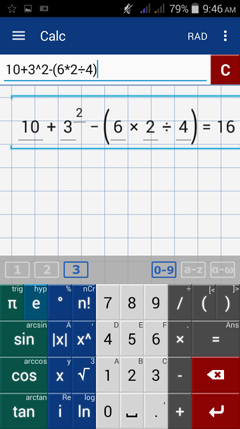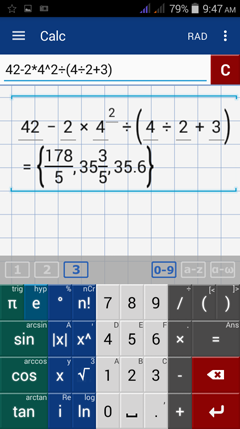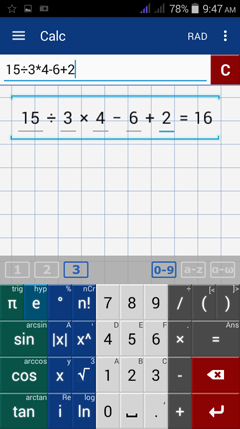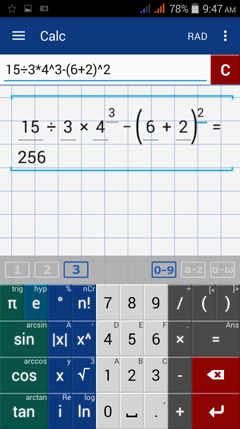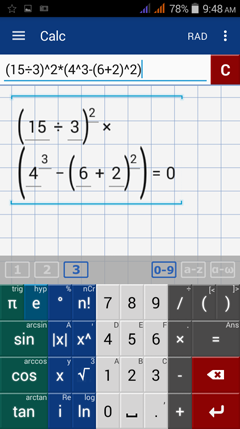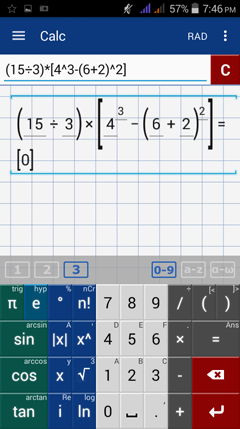6.8. Order of Operations
Simplifying expressions requires knowing the order of operations which is listed below. You can remember it according to the acronym GEMDAS.
1) G - Perform the operations inside a grouping symbol starting from the innermost to the outermost grouping symbols. Braces,
brackets and parentheses are the most commonly used grouping symbols in mathematics.
2) E - Simplify expressions involving exponents.
3) M - Perform multiplication from left to right (as the order appears in the problem).
4) D - Perform division from left to right (as the order appears in the problem).
5) A - Perform addition from left to right (as the order appears in the problem).
6) S - Perform subtraction from left to right (as the order appears in the problem).
Reminders
1) You can enter brackets [ ] and braces { } but it may be easier to use parentheses ( ) instead. You can enter as many parentheses as needed to group terms or arguments.
Note: The app uses square brackets [ ] for matrices and ordered pairs, braces { } for systems of equations and ( ) for grouping terms in a sequence of operations.
2) You can do multiplication and division simultaneously or by whichever operation comes first.
3) You can do addition and subtraction simultaneously or by whichever operation comes first.
The app uses GEMDAS. To simplify expressions that involve a series of operations, enter the expression as it appears in the problem and enter parentheses instead of brackets or braces. Use the operation keys (+, −, ×, ÷). You can access the division symbol (÷) by tapping the fraction bar (/) twice. If you want to use a dot for multiplication, tap the multiplication sign (×) twice.
Illustration
Simplify the expression below using GEMDAS.
1) G - Perform the operations inside a grouping symbol starting from the innermost to the outermost grouping symbols. Braces,
brackets and parentheses are the most commonly used grouping symbols in mathematics.
2) E - Simplify expressions involving exponents.
3) M - Perform multiplication from left to right (as the order appears in the problem).
4) D - Perform division from left to right (as the order appears in the problem).
5) A - Perform addition from left to right (as the order appears in the problem).
6) S - Perform subtraction from left to right (as the order appears in the problem).
Reminders
1) You can enter brackets [ ] and braces { } but it may be easier to use parentheses ( ) instead. You can enter as many parentheses as needed to group terms or arguments.
Note: The app uses square brackets [ ] for matrices and ordered pairs, braces { } for systems of equations and ( ) for grouping terms in a sequence of operations.
2) You can do multiplication and division simultaneously or by whichever operation comes first.
3) You can do addition and subtraction simultaneously or by whichever operation comes first.
The app uses GEMDAS. To simplify expressions that involve a series of operations, enter the expression as it appears in the problem and enter parentheses instead of brackets or braces. Use the operation keys (+, −, ×, ÷). You can access the division symbol (÷) by tapping the fraction bar (/) twice. If you want to use a dot for multiplication, tap the multiplication sign (×) twice.
Illustration
Simplify the expression below using GEMDAS.
Solution
Step 1: Observe that there two grouping symbols: brackets and parentheses.
The innermost grouping contains 3^2 + 6 ÷ 2.
First, simplify 3^2 into 9.
Then, divide 6 by 2 to get 3.
Add 9 to 3 (the quotient of 6 and 2).
Thus 3^2 + 6 ÷ 2 is equal to 12.
Step 2: Replace the group (3^2 + 6 ÷ 2) with 12 found in Step 1 and proceed to the next step.
The original expression now becomes: 24 - 2 [5 - 6 × 12].
The square brackets can be replaced with parentheses.
The new expression is 24 - 2 (5 - 6 × 12).
Step 3: Simplify the terms within the parentheses.
Multiply 6 and 12. Then subtract the product from 5.
5 - 6 × 12 = 5 - 72 = - 67
Step 4: Replace the 2nd group of terms (5 - 6 × 12) with -67 found in Step 3.
24 - 2 ( 5 - 6 × 12) = 24 - 2(-67)
Step 5: Perform the multiplication.
Multiply 2 and -67.
24 - (-134)
Step 6: Perform the subtraction.
Subtract -134 from 24. Note that a negative number is being subtracted.
24 - (-134) = 24 + 134
Final answer: 158
To see the answer in the calculator, type in the entire expression.
Step 1: Observe that there two grouping symbols: brackets and parentheses.
The innermost grouping contains 3^2 + 6 ÷ 2.
First, simplify 3^2 into 9.
Then, divide 6 by 2 to get 3.
Add 9 to 3 (the quotient of 6 and 2).
Thus 3^2 + 6 ÷ 2 is equal to 12.
Step 2: Replace the group (3^2 + 6 ÷ 2) with 12 found in Step 1 and proceed to the next step.
The original expression now becomes: 24 - 2 [5 - 6 × 12].
The square brackets can be replaced with parentheses.
The new expression is 24 - 2 (5 - 6 × 12).
Step 3: Simplify the terms within the parentheses.
Multiply 6 and 12. Then subtract the product from 5.
5 - 6 × 12 = 5 - 72 = - 67
Step 4: Replace the 2nd group of terms (5 - 6 × 12) with -67 found in Step 3.
24 - 2 ( 5 - 6 × 12) = 24 - 2(-67)
Step 5: Perform the multiplication.
Multiply 2 and -67.
24 - (-134)
Step 6: Perform the subtraction.
Subtract -134 from 24. Note that a negative number is being subtracted.
24 - (-134) = 24 + 134
Final answer: 158
To see the answer in the calculator, type in the entire expression.
If you decide to use brackets instead of parentheses, the answer is still 158 but it is expressed as a 1 x 1 matrix. A 1 x 1 matrix can be considered as a number or a scalar, so numerically, the two results are the same. It is a matter of preference whether you want to use brackets or parentheses.
Examples
Perform the indicated operation.
Perform the indicated operation.
Solutions
1) Enter the expression as it appears in the problem: 10 + 3^2 - (6 * 2 ÷ 4)
1) Enter the expression as it appears in the problem: 10 + 3^2 - (6 * 2 ÷ 4)
2) Enter the expression as it appears in the problem: 42 - 2*4^2 ÷ (4÷2+3)
3) Enter the expression as it appears in the problem: 15 ÷ 3*4 - 6 + 2
4) Enter the expression as it appears in the problem: 15 ÷ 3*4^3 - (6+2)^2
5) Enter the expression as it appears in the problem: (15÷3)^2 * (4^3 - (6+2)^2)
If you want to use brackets, tap the parentheses key twice. The answer will be expresses in a 1 x 1 matrix.
Enter the expression as it appears in the problem: (15 ÷ 3) * [4^3 - (6+2)^2]
Enter the expression as it appears in the problem: (15 ÷ 3) * [4^3 - (6+2)^2]


